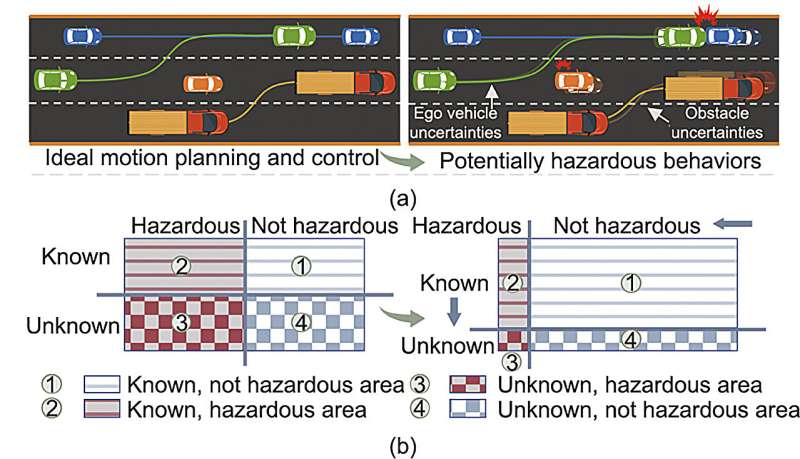This article has been reviewed according to Science X's editorial process and policies. Editors have highlighted the following attributes while ensuring the content's credibility:
fact-checked
proofread
Addressing challenges in automated driving: A safe motion planning and control framework

Automated vehicles (AVs) have become a critical link in the development of intelligent transportation systems owing to their vast potential to enhance safety, reduce energy consumption, and optimize traffic flow. With the increase of advanced functionalities included in AVs, safety during their operational phase is of paramount importance for the road vehicles industry.
However, there have been several fatal accidents involving AVs, which underscore the importance and urgency of guaranteeing their safety. The reasons for the above accidents can be attributed to three typical safety issues faced by AVs: Functional safety, safety of the intended functionality (SOTIF) and cybersecurity.
Among these three issues, the SOTIF stands out as both a current academic research hotspot and an immediate challenge for AV applications. The SOTIF aims to handle potentially hazardous behaviors, including insufficiencies or limitations related to the specifications, performance, and situational awareness, with or without reasonably foreseeable misuse, and surrounding impacts (e.g., other users, passive infrastructure, weather, and electromagnetic interference).
Given this consideration, a study published in Engineering entitled "Safe Motion Planning and Control Framework for Automated Vehicles with Zonotopic TRMPC" deduced that the current motion planning and control techniques also suffer from issues that fall within the scope of the SOTIF. For example, uncertainties such as model mismatches will inevitably lead to control errors in the future, however, the planning layer does not consider the impact of these errors within the planning cycle.
This study leverages set theory, robust control theory, and reachability analysis to propose a safe motion planning and control (SMPAC) framework, aiming at enhancing the SOTIF of automated driving under multi-dimensional uncertainties.
To realize the SMPAC framework, the authors employ advanced methodologies at both the control and planning layers of automated driving. At the control layer, they leverage set theory to efficiently analyze all possible uncertainties within the control loop through reachability analysis.
Building upon this analysis, they develop a flexible and efficient tube-based robust model predictive controller (TRMPC), ensuring convergence of all possible uncertainties' future evolutions to a minimal robust positively invariant set. Simultaneously, the TRMPC guarantees that the propagation of control errors over a certain horizon is bounded within a compact set.
Moving to the planning layer, the authors introduce a concept of safety set to describe the reachable geometric boundaries of the ego vehicle and obstacles. The safety sets are constructed according to the bounded compact set derived from control layer errors. They serve as fundamental constructs for subsequent trajectory evaluation and selection.
In summary, the deep integration of the zonotopic TRMPC at the control layer and the safety sets at the planning layer ensures that the actual trajectories of automated vehicles are always constrained within safe boundaries, thereby enhancing the SOTIF.
In hardware-in-the-loop experiments, the authors provide two typical scenarios: An active lane-changing scenario under extreme maneuvering conditions and a collision avoidance scenario under normal operating conditions. These experiments validate the safety, effectiveness, and real-time performance of the proposed SMPAC framework. They demonstrate that the SMPAC can reduce the potential hazardous/unknown regions within the categories of SOTIF in automated driving.
The authors encourage further research directions, including: Utilizing modern linearization methods to model vehicle systems, thereby refining disturbance sets to reduce the conservatism of the SMPAC framework and embedding state-of-the-art motion planning methods within the SMPAC framework to further enhance the capabilities of automated driving.
More information: Hao Zheng et al, Safe Motion Planning and Control Framework for Automated Vehicles with Zonotopic TRMPC, Engineering (2024). DOI: 10.1016/j.eng.2023.12.003















